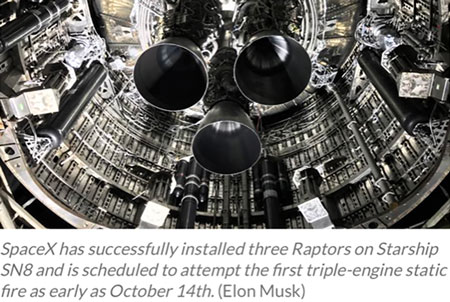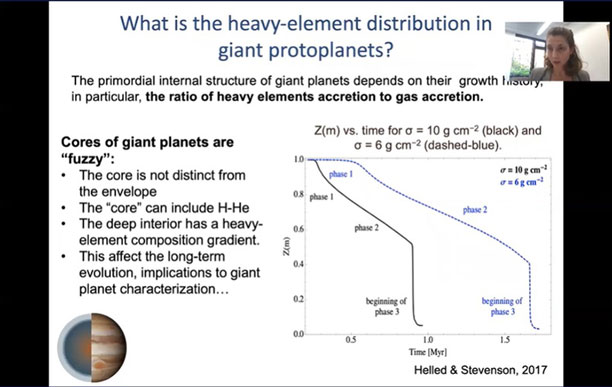Greetings from Palmia Observatory
Well here we are with some sunspots, more news about Starship SN8 and an example of social media freezing out some discussion and we end up with the week at AAS 52 Division of Planetary Science (DPS) meeting.
So the sun woke up with some more spots, but they didn't last for long. This morning when I checked they had rotated out of view or at least no visible spots today, but they were great while they lasted.
 |
Some sunspots in this 600 mm DSLR image (Source: Palmia Observatory)
|
In the social media news, I discovered that one of the scientists that I have started following has been evicted from Facebook and some restrictions on Twitter too. Bret Weinstein is a biologist and I got interested in him when I heard about how he was very instrumental in finding that the mice used in laboratory tests all over country were indeed broken. It turns out that the lab mice bred in captivity have adapted with longer sequences of telomeres in their cell nuclei. Then when studies are done on the effects of drugs and other diseases which shorten the lengths of telomeres, the damage from the drug does not show up as readily as it would in wild mice and therefore the danger of the drug is not noticed as easily. So, he was an interesting person to follow.
Anyway, the best I can tell he was banned because he was talking about a new political system where instead of winner taking the president, the presidency would be shared by the top two vote winners, called Unity 2020. Now I don't see this concept as very feasible, but it is not clear why discussion of this approach should be banned. As we discovered from the documentary, "The Social Dilemma", as mentioned in the blog post of October 1, 2020, these social media companies are not always our friends and they have their own agenda and business model and having a free discussion is not always allowed.
 |
Bret Weinstein banned for talking about Unity 2020? (Source: Twitter @BretWeinstein)
|
The other big news in the space community is the ongoing fabrication and testing of Starship SN8 at Boca Chica. Here we see an image posted by Elon showing how three Raptor engines are installed for the upcoming test hop. The interesting thing we can see that there is plenty of room for more engines when the Starship is fully populated for orbital flights and beyond.
 |
Starship SN8 with three Raptor engines installed (Source: Elon Musk)
|
The static fire test and the actual test hop is just about ready to go, but the latest news is that weather has delayed the testing and test hop. We expect to see news of the test hop any day now. Darn, I sure would like to get back to Boca Chica and follow this event!
 |
Weather delays SN8 testing at Boca Chica (Source: Teslarati)
|
The rest of the week was spent online at the AAS 52nd DPS meeting. The Division of Planetary Science meeting was held October 26-30 and had a lot of interesting presentations and discussions. There were presentations on asteroids and planets.
 |
American Astronomical Society 52nd annual DPS meeting (Source: www.aas.org)
|
There were many topics that could be mentioned here for all of you astronomer wannabes or physicist wannabes, but there is just time for one on the formation of large planets, like Jupiter. The rest of these slide screen captures comes from Ravit Helled's presentation at the 52nd DPS meeting.
 |
Linking Jupiter's interior with its formation and evolutionary history (Source: Ravit Helled, U of Z.)
|
Ravit starts off with some of the questions still be asked about Jupiter and how the study of this planet applies to other giant planets.
 |
Linking Jupiter's interior with its formation and evolutionary history (Source: Ravit Helled, U of Z.)
|
|
Trying to unravel the astrophysics of giant planet formation requires looking at accretion models and impact models. Many models predict that giant planets were formed at different locations around their protostar and then migrated to the positions that we find them now.
 |
Linking Jupiter's interior with its formation and evolutionary history (Source: Ravit Helled, U of Z.)
|
|
One model is the core accretion model. The planet just forms by material present around the young protosun just accretes by gravitational attraction. Heavy elements are expected to migrate towards the central core by gravitational action.
 |
The Core Accretion Model of Giant Planet Formation (Source: Ravit Helled, U of Z.)
|
|
What is still not known about the core is whether it is well defined spherical structure or more of a fuzzy place.
 |
Tracking the location of the heavy elements (Source: Ravit Helled, U of Z.)
|
|
The evolutionary history of the prototype giant planet must also be included in any analysis. Some formation theories are based on giant impacts that could affect the formation and structure of the core. How do we look inside the giant planet to see what happened or might have happened?
 |
Linking Jupiter's interior with its formation and evolutionary history (Source: Ravit Helled, U of Z.)
|
|
It turns out that by measuring the gravity field around large planets can be used to get a look at the insides of the planet and this is exactly what the Juno spacecraft is now doing in its orbit around Jupiter.
 |
Using Juno data to make models of Jupiter's interior (Source: Ravit Helled, U of Z.)
|
|
But as often happens, there is still not enough data or resolution to tell what is going on. As more data comes available the number of models that are rejected and those that gain more support goes on. It is really interesting to see that Juno is collecting a lot of gravitational data that depends on the actual, unseen, core.
 |
Is Jupiter's core fuzzy and very extended or not? (Source: Ravit Helled, U of Zurich)
|
|
So we have to consider the young planet and what other convective forces go on inside the formation of the planet. Formation and evolutionary history are connected. More data please! Thanks for letting us in on what is going on, Ravit!
 |
Link between planet formation and evolutionary history (Source: Ravit Helled, U of Zurich.)
|
|
So, if I find some free time there might be more comments from the DPS meeting, but in the meantime, I hope some of you are still collecting data, from your own backyard, showing how the phase of the moon changes over a month.
Until next time, here from our burrow, stay safe, as we recover more of our freedom,
Resident Astronomer George
Be sure to check out over 400 other blog posts on similar topics
If you are interested in things astronomical or in astrophysics and cosmology















No comments:
Post a Comment